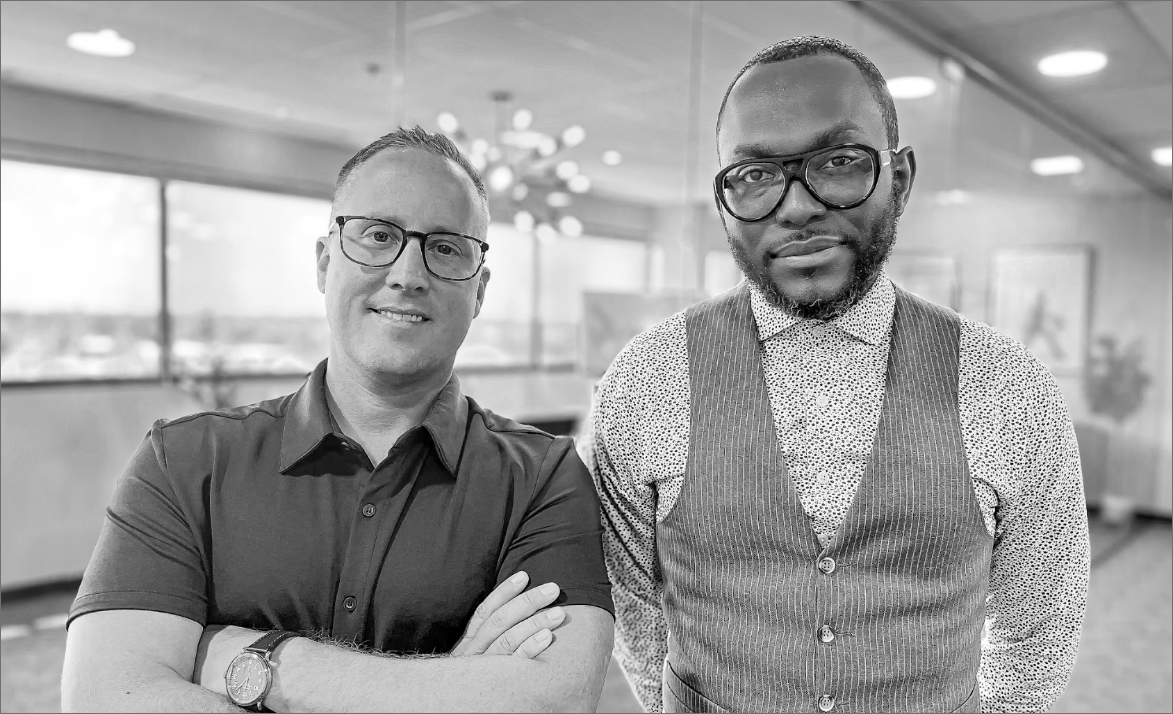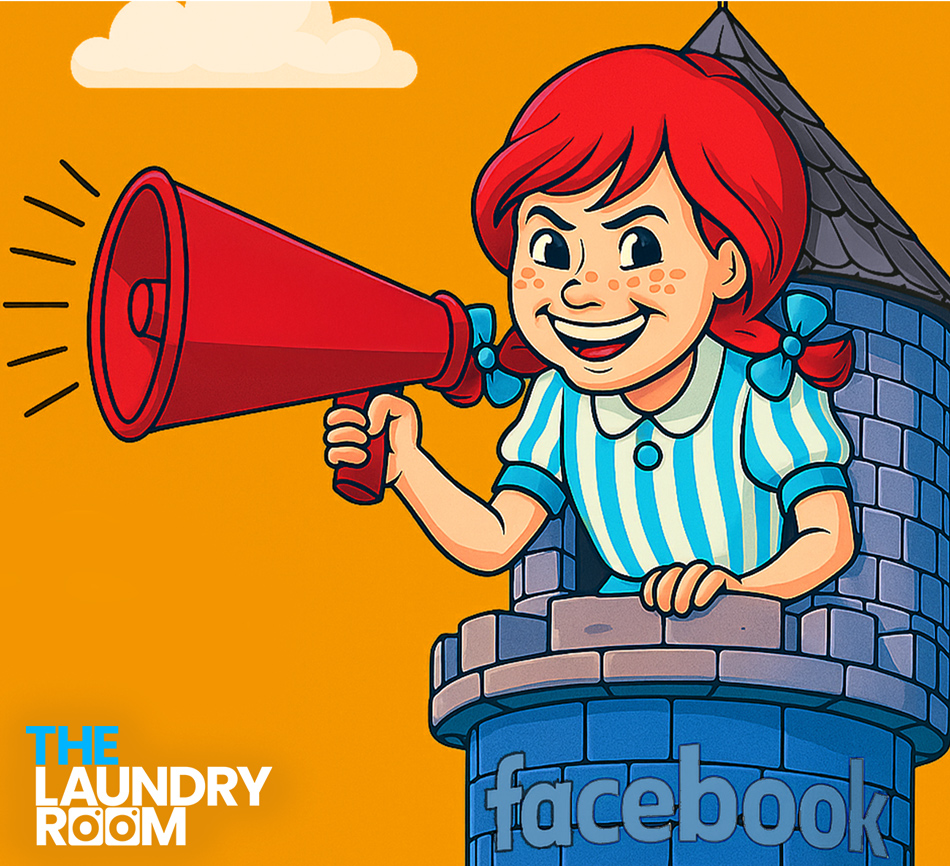00:06 – 43:21
All right, guys, welcome back to episode number four. This is The Laundry Room. I am Nick Skislak, and sitting with me is Michael Taylor too.
Michael Taylor too.
Michael Taylor too.
Get it from my daddy. All right, man, episode four. What’s up, so far?
We’re doing it.
What’s on the agenda today, Michael?
I thought we’d talk about talent.
00:43 – 01:20
All the good, the bad, the ugly of attracting, managing, and retaining talent. And I know this is a touchy subject for us because we are, we wear it on our sleeves a lot. And I tell people who ask what I do, my new go-to, I’m in the people business. What do you do? I’m in the people business.
01:20 – 01:58
Because it really does sum up all facets.
Certainly as a marketing agency, as a strategic communications firm, what is our goal? Getting right message in front of right person. And all the people that are required to do that, all the people that you have to interface with, collaborate with.
At the end of the day, we’re in the people business. Understanding people, empowering people, communicating well with those people.
01:58 – 02:31
I was telling Amy this story. I’ve told you this before, too, that I feel that agency world, it goes like professional sports teams, movie casting, like making a movie at agencies, as far as how hard and difficult it is to do the three things you said. Get, maintain, manage and retain talent.
I think with the industry, the ones that I’ve listed certainly, there’s so much that you put into it.
02:31 – 02:52
You put everything you have into your work. And with what we’re doing here to wearing it on your sleeve, you really do give it, it requires you to give it your all every single day.
And if you don’t see momentum or moving in the right direction, I think it’s an instant like, I’m out of here.
02:52 – 03:43
I put too much into this to not move forward.
I think it’s tough. I think it’s really tough.
One of the hardest, if not the hardest, jobs in the world is attracting, managing and retaining talent. My favorite example are coaches who have mega stars that they’re responsible for. And being a 90s kid, I think about Phil Jackson, the Chicago Bulls, when they got Dennis Rodman, right, towards the end of that dynasty.
And Phil Jackson has talked about this.
03:43 – 04:20
He went from coaching to managing. His whole job turned into, how do I keep these guys aligned, pull the best out of them?
They already know the game of basketball. They’re already legends and superstars in their own right. The gig now is managing them.
And you got a ton of examples of this. Bill Belichick, right, you know, arguably Steve Kerr.
04:20 – 04:47
And you can go down the line going back on some other coaches who have done a really good job of managing all the personalities, managing all of the hype, the dark back room fights and arguments that they have to somehow pull out. Oh, and by the way, you still got to do the job. You still got to deliver on what the goal is,
04:47 – 05:21
win a game, in our case, deliver what matters to clients, do meaningful work, make sure the people around you are being fulfilled.
And so that idea of I own the goal, but manage all of these agendas that are around you. It’s a super tough day. And when I think about even the creation of what we’re doing here, this experiment, The Laundry Room, it is in part to talk about all the dirtiness that you uncover.
05:21 – 05:49
You uncover in yourself, you uncover in the business, you uncover in people around you. That’s the work, man. Day in, day out.
Yeah. Pulling some stats from this. Magnus, thank you very much.
Average tenure in a marketing agency or the marketing industry today, 3.2 years, which is basically, I mean, I remember that being the statistic for an NFL running pack.
05:49 – 06:14
Like, I think that was like 2.5. But why do you think that is?
Like, why do you think? Now, I will say, you know, this, the employment has changed over the last 30 years, right? Where old mentality was, hey, go get a job.
Stay at that job or stay with that company forever and eventually work your way up.
06:14 – 06:41
Now, I think the pattern is, hey, go get three years, three to five years at a place, learn everything you can, and then go take the next opportunity and jump around.
Yeah, why that is, you know, I have a few thoughts and a few bullet points that might be triggering.
Oh, gosh. I won’t get angry.
06:41 – 007:03
Might be triggering for us, but I’ll try not to cry either.
You know, I know that anyone listening to this who is in a position of attracting talent, managing that talent, they can relate to this.
Before you do this, let me share one story.
Yeah.
So I’m talking to a, I have a, I’m just going to say it’s a colleague.
07:03 – 07:29
It’s a colleague in the business. Had an employee, so getting into this retention game, had some performance issues.
This is a young, this is in the, call it 25 to 34 year old, 20, maybe younger. I don’t know. Had some performance issues.
In big agency, if you have issues, your go-to is go to HR, right? You don’t have to really deal.
07:29 – 07:50
They’ve removed that a lot in many ways of having to deal with those kind of conflicts.
Management is conditioned kind of to go, hey, go talk to HR about it. If you got a problem with it, go talk to HR about it. Well, the gal I’m talking to wanted to give her a heads up, right?
07:50 – 08:15
she did come in as mentor, leader, manager and say, hey, we’ve got some issues. We’ve got some big issues going on with your performance. Here’s what they are.
Let’s work together to get these figured out. And it was not accepted, right? It was untrue.
It was blasphemy. It was, where did this come from? How could you think this?
08:15 – 08:41
No chance. Oh my goodness. And three days after the conversation, employee quit on the spot.
Gone. Yeah. What a great work environment we have to be able to, I mean, odds of her getting another job within two to four weeks are probably pretty good, no?
Absolutely.
So, I mean, we didn’t, you know, on our come up, I guess we’re still on the come up, but our early come up,
08:41 – 09:06
we didn’t have that option. I think it’s much more of a reality now. We’re like, I can go, the idea that, hey, I can go get another one of these.
But my point in bringing up this story was the acceptance. Here was someone that was willing to invest in you, help you grow, and you throw the opportunity away. I think that happens a lot.
09:07 – 09:42
Yeah. I think the setting clear expectations is one of the issues that we’ve experienced a lot, that I think people experience a lot, on both sides, both as employer and as employee, of making it crystal clear what the expectations are in the role. And with the competition that exists now, both at the employer level and employee level, right?
09:42 – 10:07
Because you’re right, that person was able to leave there and guaranteed had…
Or could, could go get…
Two or three opportunities in a matter of days. Setting the right expectation, here is what’s expected of you. And that is a tricky balance because it’s one part, here is what the day-to-day work is,
10:07 – 10:33
and then it’s one part, here’s how you have to deliver the intangibles while you’re doing that day-to-day.
Here’s what we care about. Here’s how you need to assimilate to what we’re doing as a company. Here’s how you need to be flexible in doing that work.
There are all of these things that are not clear at the onset.
10:33 – 11:06
And when it is unclear, and you know my favorite saying, when people don’t know, they make it up. And when you make it up and you believe it long enough, it becomes truth.
And once it is true to you, nobody can tell you different. And that one misstep of not giving that clarity in what the expectations are in the role, not just in the job duties, but in the role, is a big miss for people responsible for talent.
11:06 – 11:36
And I think we’ve, you know, we had way too many examples to cover in this episode of where we’ve been horrible at that.
But the learning, the lessons from us, has made us more sensitive, more aware of working on clarifying expectation. And I have to imagine that that ability is changing now for managers, for business leaders.
11:36 – 12:02
The art of communication is so much more important now than it used to be.
That’s the thing too. When you talk with what we’re doing, and I’m not trying to say we’re professional athletes or movie stars or anything, but the level of trust that you have to have with a team, and even you talk about the bulls, or you talk about when a great movie is made, those examples, it is more than just the skill.
12:02 – 12:26
So it is more than just how good you are at the thing you do.
Just as important is how good you can collaborate, share, feel trusted, feel safe, feel confident in yourself to be able to take enough risks that matter to the group that you’re contributing to. That’s where I think it gets really hard when you look to get a new person on.
12:26 – 12:50
You come with a great book and done great things, but just as important, it’s hard to see those intangibles, kind of, and it does.
To provide clarity on that, hey, we want you to be kind of funny sometimes, and then we want you to be really funny other times, and then when we’re doing this stuff, we want you to be really serious. To temper personality, you can’t do that.
12:50 – 13:22
Yeah. On that, that’s a good segue to another point. Ignoring the character of a person or the personality of that person, because you can often miss the balance between hard skills and soft skills.
And we’ve seen that with what we’re doing here at the shop of the evolution of all in on hard skills.
13:22 – 13:45
We only care that you know how to do a thing, to wait a minute, that slapped us in the face. No, we need some people with some bedside manner, who know how to work well with others, who know how to be empathetic, who know how to read a room.
And so that evolution of going back and forth between those two sets of skills, that is really tough.
And keeping it balanced,
13:45 – 14:03
I think what I fall victim to, and I think I’m getting better, I’m trying to get better, but if you do, to me, if you do a really good thing in one of those, I want to shower you and build you up and appreciate you and tell you how great you’re doing. When you don’t, when you miss it,
14:03 – 14:25
I’m less likely to, like I’m trying to get better at calling that out as well, but I get so excited about the good that I don’t want to stop it or stifle it, and I keep some of that stuff hidden, and I shouldn’t. I think that’s a common thing.
It’s really, it’s nice to go up and high five someone and say, way to go, man.
14:25 – 14:40
You’re doing a great job. It’s way more different of, hey, come over here, I got to talk to you for a second.
You did this, this ain’t it. We got to get better. You’re still crushing it, way to go, but look, this is why it is, and this is what it needs to be.
14:40 – 15:08
Yeah, you’re in my head. I mean, those are things that are symbiotic. So understanding what you need in the personality or the character of that person to do a role.
Got to have the hard skills. I think that’s barrier to entry. It’s easy to test for, right?
You can figure that out.
Table stakes, right?
15:08 – 15:34
That gets you in the door. What keeps you in the door is your ability to demonstrate those intangibles.
Now for leadership, for management, providing that real time crucial feedback, right? And sometimes that communication is stifled to your example of, hey, we want to celebrate all the good. Yeah, but that’s not where the wins happen.
15:34 – 16:00
The wins happen in challenging the trouble spots, right? Challenging, having the difficult conversations about this is where we got to get better. This is where we need to see improvement.
Not because you’re not doing good things. It’s not because good things aren’t happening. It’s because better things can happen.
And this is how that better is going to impact what we’re doing as a company.
16:00 – 16:33
And that is tough. That’s part of the being in the people business, because you’re right.
There are that balance between team member appreciating that or accepting that versus to your story of, yeah, I’m not here for that. I’m out. Right?
So your investment, I tell our team members all the time, this is a, you being here is an investment, and I fully expect a return. So I’m going to do whatever I have to, to realize that return.
16:33 – 17:00
And it’s a two-way street, right?
They have to do the same thing of, they have an investment that they’re making, and they’re expecting a return. So to make sure that left hand knows what right hand is doing, that we understand what the individual goals are, and then make sure we’re aligned on the singularity goal. And that’s where people, I think, it’s really easy for people to go
17:00- 17:21
in different directions.
That’s our safety over comfort. That’s exactly what it is. It’s not comfortable to have those conversations, but when you do, you’re providing a very, very safe environment.
And if you can do that and have everybody involved feel safe, man, that’s when you can do some great things,
17:21 – 17:49
win championships, have a healthy work environment.
You know, the biggest lessons I’ve learned, certainly in trying to attract talent, is I’ve had some really good interviews. I’ve interviewed, you’ve heard me talk about this. I’ve been a part of some amazing interviews.
And you want to talk about crapshoot. Right, what comes out on the other end of that.
17:49 – 18:08
I’ve had some interviews that you could not have done or you could not have told me, this person isn’t going to be a rock star.
This is a rock star.
You know, I would say up until only a couple years ago, everyone I interviewed, I loved, like, all of them. I couldn’t, I don’t think I could count on one hand interviews that I’ve had where I was like, oh man, that didn’t go well.
18:09 – 18:39
Oh, that was no good.
I’m looking at everyone we meet and I’m going, get them in here. This is going to be great. This is going to be fantastic.
We’ll figure it all out later. Get them in here.
No. And that’s the miss, because for all of the goodness that I believe people want to see in other people, attracting, managing and retaining is about seeing the vulnerabilities.
18:39 – 19:04
Both seeing the vulnerabilities, but then also seeing the opportunity.
There’s an infant skill here. If we put him in this environment, that thing is going to blossom, it’s going to grow. But inversely, there’s a vulnerability here.
If we don’t grab hold to that and make sure we can speak to it, correct it, it will blow this place up.
19:04 – 19:31
And that’s the challenge in those interviews. So you get in and you have these amazing conversations because you innately want to see the good, you innately hear the good.
You don’t want to only see the bad, right? And you miss on both sides. Sometimes you disqualify a candidate because you only saw the vulnerability.
You didn’t see that infant skill that was there.
19:31 – 19:52
And then other times you hire people that you had no business hiring because you only saw the infant skill and not the vulnerability that could blow this joint up. And we get stuck in that.
We get stuck in that. I know I have.
Well, and I think that we’ve talked about this before. I read this and it was positioned as an ego thing.
19:52 – 20:15
But the story goes that you hire someone as a leader, as a manager.
You hire someone. You don’t want to admit to yourself that you made the wrong move. So you’ll let three months go by.
You’ll let six months go by. You’ll kind of, oh, if I could just, if I, oh, one more thing. And you’re kind of tied up.
Now, in what I was reading,
20:15 – 20:41
it was related to your ego. It’s our own ego going, you didn’t make a bad move. Hey, no, I knew.
He’s there. He’s in there somewhere. She’s in there somewhere.
Now, I think part of that too comes with the relationship that’s built in a relatively short amount of time with the work that we do. It’s not like we hire people in and they’re sitting in a cubicle, and you only see them when you’re going to the drinking fountain. Like we do highly collaborative work,
20:41 – 21:16
you’re spending a majority of your waking hours together.
So no matter what’s happening, there’s a relationship that’s being built. And if that’s even a shred of good, you’re overlooking a lot of other things that are really doing you a lot of damage, doing a lot of harm to the organization.
Yeah, and I think in those interview processes or that courtship phase, making sure that both sides communicate what they value, what they care about.
21:17 – 21:35
You know what I think I’ve learned big time too is that changes. That’s why you got to do it all the time. Overtime, yes.
I think I heard this joke or maybe it’s a saying or something, but when you’re in your 20s, you want to be the president. When you’re 30s, you want to be the governor. When you’re 40s, you want to be the mayor.
21:35 – 21:53
By the 50s, you want to be a really good husband and a good dad. Your priorities shift. You have different changes.
As you get older, sometimes you want to travel when you’re young. Well, then you’re done with that, you want to buy a house. So where you want to sit,
21:53 – 22:12
even shifting, you have kids, you want work-life balance now.
You don’t want all these shifts happening. I’m giving kind of big ones, but these things do change over time. And if we’re not management, leadership, isn’t staying in tune with those things, you could have people on a path that, oh, hey, six months ago, this is what they said they wanted.
22:12- 22:40
Well, that was six months ago. That was three months ago. That’s old news.
That ain’t it anymore. Staying in tune with that is tough.
Yeah, and for growing companies, when the needs change, doing a good job of communicating that to the team, to that individual, because what they might have been hired for may be different now.
22:40 – 23:05
And so communicating how the expectation has evolved, where the opportunity now lies. Hey, yeah, you came in doing this thing over here.
That thing’s all set now. We need you to change and focus on this new challenge. Are you okay with that?
Are you good with that? And both sides have to be accepting of, the answer might be no, I’m not good with that.
23:05 – 23:36
And kind of segues into my next thought of not doing a good job of owning that candidate’s success after they come in.
It’s not enough to say, yep, these guys are good to go, get them in the team, and set them on their way. No, no, no. You have to, somebody has to be accountable to what that person is doing.
23:36 – 24:10
And that adage, higher, slow.
Slow to higher.
Quick to fire, right? Truer words cannot be spoken. Because if you are hasty in bringing somebody in who didn’t pay attention to those vulnerabilities, or you didn’t identify where challenges need to be mitigated, you’ll look up really quickly, and they aren’t fulfilled, right?
24:10 – 24:30
They’re just going through the motions.
They’re lost. They have no idea what they’re doing. Yes, that’s a piece too.
And then you have, it’s a domino effect, because then that vulnerability goes away, people aren’t being honest with each other, leadership is in the dark about what the truth is.
Team member loses confidence in the company?
24:30 – 24:58
Oh, yeah.
This place ain’t going to be around in two years.
Hey, man. I mean, we have those scars where it is night and day perspective. You have one perspective about what’s happening, and team members have a completely different outlook on what’s happening.
And that is because there is not that constant realignment of, yeah, what I cared about when I first got here was this.
24:58 – 25:26
Now, because of what I’ve seen, what I’ve done, what I’ve experienced, I care a little bit less about that, and I care more about this. Does that align?
Does that align with what you care about, company, and my involvement here? And that, I think, requires those soft skills. You know, being open to that conversation, being accepting of whatever is shared.
25:27 – 25:44
I think that’s why it has had so much success.
On our team.
On our squad, because she’s been so vocal. And we did a really good job, too, of what it is and what it isn’t.
She had a lot of things that she didn’t want to do. Then she had things that she did want to do.
25:45 – 26:06
Then she had life things that happened outside of work, outside of where she’s got a family, too.
So us being in tune, us being safe enough with each other to talk about these things, that we could set it. And what is she? I think she’s at six years, seven years.
Six years in, yeah. Yeah, and there’s a…
26:07 – 26:24
That’s cool. That’s really special. And I think a lot of it is because we’ve…
Her, too, not just us, but her, too, it was easy for us to adapt because we knew what we had to adapt to. If she wouldn’t have been open with us or shared these things with us, we would have made it up.
26:24 – 26:52
And vice versa.
Totally.
You got to do the same thing for her. And that ownership is a mutual responsibility, right? Team member has to be accountable for their desires, their goals.
And when it is not happening, that’s where coach leadership has to come in and say, hey, this is what I’m seeing or not seeing.
26:52 – 27:22
Here’s what it means. And be very clear about that.
And that’s where I think we’ve had a challenge in doing that. We have really easy to, from Phil Jackson, really easy to coach the game to a superstar. That’s easy.
Managing, though, how do I keep that person engaged? How do I make sure we have an open dialogue? When that rock star is going through something,
27:22 – 27:45
do they feel safe enough to share that with me?
They got something going on outside the game that’s going to impact the game. Is this a safe enough space for them to give me that intel? Because then leadership, coach can make whatever adjustments are necessary to still get the best out of that person.
Inversely, team members got to do the same thing, right?
27:45 – 28:23
They got to be able to recognize when there is a change happening and be committed to that. The last thing that I had on my list, thinking about this was, you know, why do companies have a hard time attracting, managing, retaining?
Bad succession planning. And what I mean by succession planning is you have someone who is growing, and they are now going to take on a new role or new responsibility.
28:23 – 28:51
Are you proactive, preemptive enough to backfill the work that they are now leaving a void in?
Yeah.
Right? Is there a clear roadmap for that person’s growth? How do they see very clearly, here’s what I’m marching towards?
And so for leadership, you have to be five steps ahead at all times. Five steps ahead. Accepting that those steps might change in real time.
28:51 – 29:15
That, okay, yeah, this is where we’re headed. This is where this person is going. And then something changes, and you have to pivot.
And not doing that is, I think, one big contributing factor to some of these stats. You know, with the average retention being less than five years, or people leaving, and, you know, most people quit leadership.
29:15 – 29:41
They don’t quit the company.
They quit people. And so not having…
I think it’s their first level-up manager. That’s who they quit.
Yeah, yeah, absolutely.
So it’s not even as broad as leadership. It is literally 80% of the time the one level-up manager that ends it.
So that, having that outlook of what does this role need,
29:41 – 30:05
what are the future roles, where does this person fit in that mix, and do we have the backfill? I remember the first time I lost a creative person on our team, and they quit me.
Uh-huh, heartbreak, man.
Heartbreak.
Heartbreak.
It was, man, you’re talking about… That was tough, man.
30:05 – 30:30
That was tough. And it, a lot of introspective moments, right?
Self-doubt, yeah, all that, all that.
Right, just really trying to understand, okay, where did I miss it? You know, here it is. If you had told me weeks before, I wasn’t missing it.
I was batting a thousand. No, man, you were out of sync. You did not understand what that person cared about.
30:30 – 31:00
And it was a good lesson because it made me more sensitive, made me more aware of what was going on. I asked a lot more questions of team members. Hey, this is what I’m seeing.
Do you agree? This is what I’m not seeing?
Yep. And I would say as like an RC, what I think I would tell the folks coming up is be super vocal about that stuff.
31:00 – 31:08
I think there’s this like fear.
I don’t know if it’s fear based, insecure based,
31:08 – 31:26
afraid that they’re not providing enough value. I don’t know why, but like it’s really hard, I think, for folks to share the vulnerabilities or the things that they’re unsure about. So they pretend that they’re okay on them.
They could get over that hump and really come to the table of hey, this is what I’m really digging right now.
31:26 – 31:45
This is what I’m not. What does this mean, right?
Does that mean I’m not fit for account management? Does that mean I’m not a creative? If you could come to the table with that stuff, I think that’s the breeding ground for growth.
You want to grow quick, get good at doing that.
31:45 – 32:08
And that is where you’ll see fast growth. If you hide that stuff and you’re not true, you got to be true with yourself first.
That’s maybe easier, sometimes hard, but you can do that. Actually sharing it with the people that are responsible for your growth, your promotion, your thing, that’s the hard part. And I think that would, that’s a shortcut.
32:08 – 32:35
That’s definitely a shortcut.
Well, you know, I think we spend a lot of time on maintaining or increasing the retention of our clients. And we have a pretty decent track record of that, of how long we keep clients. And so I know one of the things we’ve spent a lot more time talking about is replicating that with the team.
32:35 – 32:57
Because we haven’t had that great of a track record or that longevity with the majority of a team. And granted, we’re in a tough industry, right? Our space has more turnover than other industries or spaces.
But you still want to be, that’s the funny thing too, like if it’s three years, we want six.
32:58 – 33:35
And you know, ego again, hey, we can do it, come on, six, three. Four is not good enough, even though it’s 25% higher than what the average is, right?
It’s tough.
Yeah, and so those knowing, certainly for those listening who are in a position of leadership, a position of responsibility for attracting talent, retaining that talent, those soft skills, man, having those hard conversations. Last year, I think you said this to the team, one of your goals,
33:35 – 34:05
I want to have a difficult conversation with every person.
Yeah, totally.
And for what? To practice that line of communication, to practice being vulnerable and instilling or creating the trust, the confidence that people can be honest. Honest with yourself, honest with those that you are collaborating with.
And hey, we’ve had, we got many examples where that’s gone well.
34:05 – 34:27
I am proud of that. We got many examples where it’s gone well.
We got many more where it hasn’t gone well. And so taking the lessons from that and applying it is today’s work. It will be waiting for us tomorrow as well when we show up.
So this is maybe part one of this conversation.
34:28 – 34:45
I think certainly this will be a ongoing, we’ve been having the same conversation for about 13 years now. So we’ll put a comma on it.
Listen, this is The Laundry Room. Hope you enjoyed this conversation. Share it with somebody.
Let somebody know we’re talking dirty over here.

















